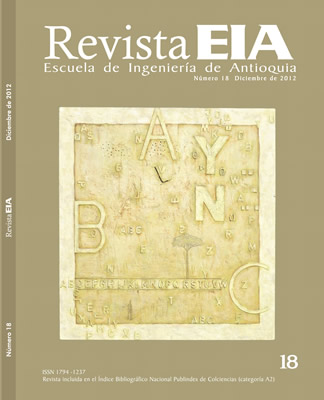EFECTO DEL OZONO EN LA REMOCIÓN DE MATERIA ORGÁNICA DISUELTA DE UN EFLUENTE SECUNDARIO (EFFECT OF OZONE ON THE REMOVAL OF DISSOLVED ORGANIC MATTER FROM A SECONDARY EFFLUENT)
EFECTO DEL OZONO EN LA REMOCIÓN DE MATERIA ORGÁNICA DISUELTA DE UN EFLUENTE SECUNDARIO (EFFECT OF OZONE ON THE REMOVAL OF DISSOLVED ORGANIC MATTER FROM A SECONDARY EFFLUENT)


This work is licensed under a Creative Commons Attribution-NonCommercial-NoDerivatives 4.0 International License.
Copyright statement
The authors exclusively assign to the Universidad EIA, with the power to assign to third parties, all the exploitation rights that derive from the works that are accepted for publication in the Revista EIA, as well as in any product derived from it and, in in particular, those of reproduction, distribution, public communication (including interactive making available) and transformation (including adaptation, modification and, where appropriate, translation), for all types of exploitation (by way of example and not limitation : in paper, electronic, online, computer or audiovisual format, as well as in any other format, even for promotional or advertising purposes and / or for the production of derivative products), for a worldwide territorial scope and for the entire duration of the rights provided for in the current published text of the Intellectual Property Law. This assignment will be made by the authors without the right to any type of remuneration or compensation.
Consequently, the author may not publish or disseminate the works that are selected for publication in the Revista EIA, neither totally nor partially, nor authorize their publication to third parties, without the prior express authorization, requested and granted in writing, from the Univeridad EIA.
Show authors biography
Este artículo presenta los resultados del estudio sobre tratamiento con ozono y posterior fraccionamientode la materia orgánica disuelta (MOD) en el efluente secundario de la planta de tratamiento de aguas residualesde Cerro de la Estrella, localizada en la Ciudad de México. La ozonación se realizó con dos concentraciones deozono en fase gaseosa (5 y 25 mg/L) y con dos tiempos de contacto (10 y 20 min). El fraccionamiento de la MODse hizo con las resinas XAD-4 y XAD-8, con el fin de determinar la cantidad de materia orgánica hidrofóbica ehidrofílica presente en el agua residual. Los mejores resultados de remoción se alcanzaron con una concentraciónde ozono de 25 mg/L y con un tiempo de contacto de 20 minutos, logrando remociones del orden del 85 % encolor, 63 % en turbiedad, 71 % en demanda química de oxígeno (DQO) y 78 % en UV254. También se determinóla composición de la MOD del efluente secundario en términos de carbono orgánico total (COT), encontrándoseque el ozono hace que la materia orgánica hidrofóbica del efluente disminuya de 46 % a 32 % y la materia orgánicahidrofílica aumente de 32 % a 42 %.
Abstract: This paper presents the results of treatment with ozone and subsequent fractionation of dissolved organicmatter (DOM) from secondary effluent from Cerro de la Estrella wastewater treatment plant located in MexicoCity. The ozonation was carried out with two concentrations of ozone in the gas phase (5 and 25 mg/L) and twocontact times (10 and 20 min). Fractionation of DOM was made using the resins XAD-4 and XAD-8, in order todetermine the amount of hydrophobic and hydrophilic organic matter present in the wastewater. The best resultswere achieved with a concentration of 25 mg/L and a contact time of 20 minutes, achieving removals of 85 % color,63 % turbidity, 71 % chemical oxygen demand (COD) and 78 % of UV254. We also determined the composition ofDOM of secondary effluent in terms of total organic carbon (TOC), finding that ozone causes the hydrophobicorganic matter from the effluent studied to decrease from 46 % to 32 % and the hydrophilic organic matter toincrease from 32 % to 42 %.Article visits 397 | PDF visits 205
